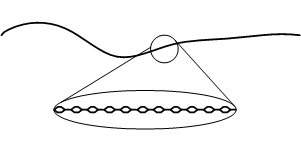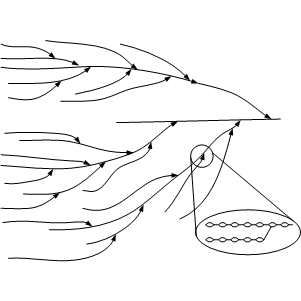Mashing is the process in which the milled grain is mixed with water. This activates enzymes that were already present in the barley seed or have been formed during the malting process. These enzymes work best in particular temperature and pH ranges. By varying the temperature of the mash, the brewer has control over the enzyme activity. In essence, mashing needs to been seen as an extension of the malting process. The following sections describe the enzymes that are more or less important for the mashing process.
Contents
Starch converting enzymes (Beta Amylase, Alpha Amylase, Limit Dextrinase)
Starch conversion is the most important aspect of mashing. In barley starch makes up 63% - 65% of the dry weight. Brewer's yeast can only ferment monosacharides (glucose, ???), disacharides (maltose, ???) and trisacharides (matotriose, ???). The latter is only completely fermentable by lager yeas strains (s. uvarum). But the malt contains mainly starch which is a polysaccarid (very large chanis of glucose) that is insoluble in water.
In order for that starch to be converted into water soluble sugars (fermentable and unfermentable), two processes need to happen. First the starch is gelatenized to become water soluble. For starch found in barley and wheat malt this happens above 140 *F (60 *C). Other starches (rice for example) gelatinizes only above 194 *F (90 *C) and require boiling (see cereal mash) before they can be converted by enzymes. Secondly the amylase enzymes break the long chained starch into shorter chains.
The starch found in malt is composed from Amylose and Amylopectin. Amylase is a single chain of glucose molecules liked between their 1st and 4th carbon atom (called 1-4 link). 17-24% of barley starch is Amylose [Narziss, 2005] the remaining 76-83% is Amylopectin. Amylopectin has a branches structure. These branches are formed by bonds between the 1st and 6th carbon atom of 2 glucose rings (called 1-6 link).
Beta amylase produces Maltose, the main wort sugar, by splitting 2 glucose molecules from the non-reducing end of a glucose chain. It is therefore able to completely convert Amylose. But since it cannot get past the branch joins, Amylopectin cannot completely be converted by beta amylase. The optimal pH range for beta amylase between 5.4 and 5.6 and the optimal temperature range is between 140 *F (60 *C) and 150 *F (65 *C). Above 160 *F (70*C) beta amylase is quickly deactivated [Narziss, 2005].
Alpha Amylase is able to split 1-4 links within glucose chains. By doing so, it exposes additional non-reducing ends for the beta amylase. This allows for the further conversion of Amylopectin. The optimal pH range is between 5.6 and 5.8 and the optimal temperature range is between 162 *F (72 *C) and 167 *F (75 *C). Above 176 *F (80 *C) alpha amylase is quickly deactivated [Narziss, 2005]
Protein converting enzymes (Peptidase)
Other Enzymes active during mashing
Glucanase
Phosphatase
Maltase
Sources
- [Narziss, 2005] Prof. Dr. agr. Ludwig Narziss, Prof. Dr.-Ing. habil. Werner Back, Technische Universitaet Muenchen (Fakultaet fuer Brauwesen, Weihenstephan), Abriss der Bierbrauerei. WILEY-VCH Verlags GmbH Weinheim Germany, 2005
- [Fix, 1999] George J. Fix Ph.D, Principles of Brewing Science", Brewers Publications, Boulder CO, 1999


